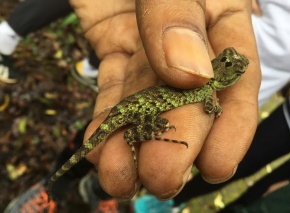
A trip to Kabini should atleast be between 4 nights and 5 days so that it allows students to explore these activities curated for this module comfortably, with clear learning outcomes.
Given below are a few activities that can be conducted at this destination, along with the appropriate age group. Our forte is customisation, so feel free to select ONE, ALL or ANY combination of the below activities to design a trip unique to your curriculum and experiential learning needs.
In this activity, the focus will be on understanding the eco-system of moist and dry deciduous forests of Kabini and the role and importance of various floral and faunal species that use this ecosystem. Students will learn about the interdependent food chains that exist in the forest. They will also explore the geographical significance and relevance of Kabini River to the forest ecology. They will also get a chnace to interact with the forest department to understand their role and perspectives of the forest department and how they operate.
Tigers are apex predators, primarily preying on ungulates such as deer and bovids. They are territorial and generally solitary but social animals, often requiring large contiguous areas of habitat that support their prey requirements. Over the past 100 years, they have lost 93% of their historic range. It is important that students understand issues such as habitat fragmentation, poaching, that threaten the survival of this Schedule I protected species.
Students will use worksheets to note down their observations during the safari. These observations will then be discussed during the review and reflection session with an experienced naturalist.
In this activity, the focus will be to assist students in developing observation and identification skills. They will be provided with a bird guidebook and will be divided into groups. They then will be alloted two spaces where within a specific time, they have to identify as many bird species as they can.
Students will get to interact with the forest department officials to better understand the management of the forest and their responsibilities. Students will design an interview module post the slideshow for their session with the forest officials as part of the green champions’ module.
CONSERVATION CONCERN
Growing tourism, development and increasing habitat fragmentation is a cross cutting issue that is affecting this region. Dams on the Kabini river, further compromise the movement of animals during the monsoons, as the dams cause certain areas to flood. Being a small sanctuary, corridors are needed to link the area to larger nature reserves in the range, to allow free movement of migratory animals and megafauna such as elephants or leopards.
However with increasing urban pressure on the fringes of the park, these corridors are often compromised. By exploring this area, students will see these ecological concerns firsthand and understand the methods in which they can be mitigated.

Related Destinations

Region: India
Active Modules: Terrestrial Ecosystem Exploration, Project Based Trips, Life Skills Expeditions

Region: India
Active Modules: Terrestrial Ecosystem Exploration, Project Based Trips, Service and Sustainability

Region: India
Active Modules: Terrestrial Ecosystem Exploration, Project Based Trips

Region: Borneo
Active Modules: Terrestrial Ecosystem Exploration, Project Based Trips

Region: India
Active Modules: Terrestrial Ecosystem Exploration, Project Based Trips, Service and Sustainability

Region: India
Active Modules: Terrestrial Ecosystem Exploration, Project Based Trips, Service and Sustainability

Region: India
Active Modules: Terrestrial Ecosystem Exploration, Service and Sustainability

Region: India
Active Modules: Terrestrial Ecosystem Exploration

Region: India
Active Modules: Life Skills Expeditions, Project Based Trips, Service and Sustainability, Terrestrial Ecosystem Exploration

Region: India
Active Modules: Project Based Trips, Life Skills Expeditions, Service and Sustainability, Terrestrial Ecosystem Exploration










